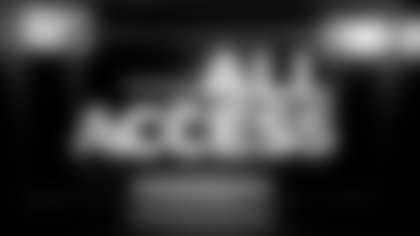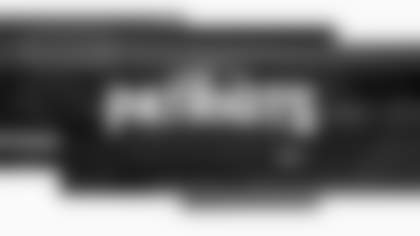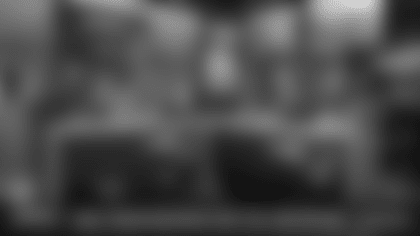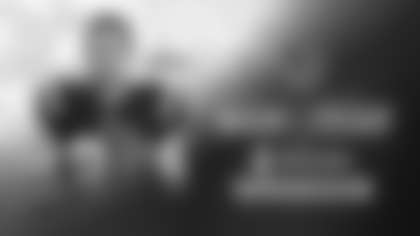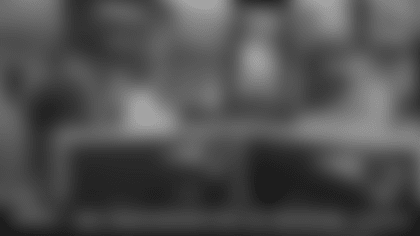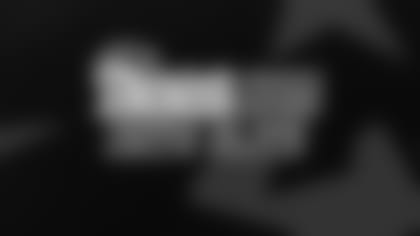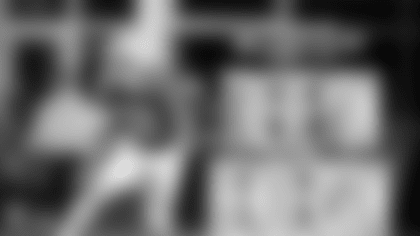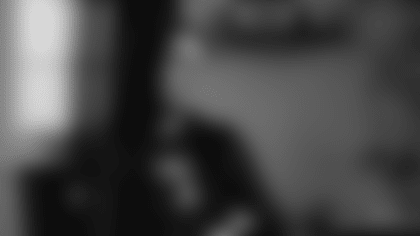[

]()
BB: I thought we had a nice workout last night. I thought we had a good level of intensity and crispness but still at the same time it was not a full contact session. I thought we got a lot done. We are going to try to continue on that format for one more day here with more of an emphasis on special teams and try to clean up some of the situations that we haven't gotten to or ones that we have covered that we didn't quite get right and then we will start on our preparations for Philadelphia tomorrow. I think we will hold off getting into them for a day or so. We are coming to the real training camp part of it, not that we are going out of camp, but we are going to start getting ready for these preseason games. That kind of takes away from the true working against each other, the true training camp type of practices and emphasis and it becomes a little bit more specific to a particular opponent starting tomorrow.
Q: How many meetings do you go through in one day?
BB: Well, we meet between every practice. So today we are having one practice, then we will meet in the morning and meet at night. Yesterday we had two practices and we met in between those two practices for a couple of hours. Each one of those meetings is about two hours.
Q: Team-wide or do you break it down by position?
BB: It starts as a team and we go over special teams and then break into offense and defense and specific individual groups. Sometimes more than others. Sometimes the team meetings are longer, sometimes they are shorter, sometimes it is 'O' and 'D' teams. Sometimes it is more individual meeting time depending on what we are covering and what the teaching and installation is. But it is some combination of all of those.
Q: How productive have the meetings been?
BB: Well, you see the results of those meetings out on the field. If it is not going good out on the field then it either hasn't been covered well in the meetings or it hasn't been understood well for the most part, that is just part of the transfer of information. Sometimes you have physical mistakes on the field and that is one thing. But learning and the process and putting it all together, that occurs in the meetings. Also during those meetings, sometimes we break up and lift weights. So, one group will meet and the other group will lift and then we will switch it around, that kind of thing. It is covering a lot of information and going over a lot of corrections, it is a combination of installation of new material and watching the tape from practice and correct it, either team mistakes or individual one-on-one drills, talking about technique and that kind of thing, it is usually one of those two things.
Q: As a coaching staff, how ready are you to start playing the games?
BB: I think we are ready for that. We have had, this will be 15 practices today, not counting the earlier ones that we had but 15 as a full team. I think we have been on a schedule and on a pace to get covered the things we need to get covered in training camp. Now we are ready to start moving into more specific type game preparations, it is just a little bit different schedule and different emphasis but that is the way it is going to be during the year so it is good to make that transition. I would say we are about ready for that, yes. A lot of teams did scrimmages this past weekend to maybe push that ahead a little bit, but I think everybody is sort of in the same boat after about 10-15 practices, somewhere in that range, you are probably ready to move on to seeing something besides what your team does on its respective side of the ball.
Q: Last year at this time, before you signed Ted Washington, you were sort of playing nose tackle by committee.
BB: Well, that is not true. We had several people competing for the position. We have that now. We have multiple people competing for the same position at other positions.
Q: The people who are competing for the positions this time, how significant an upgrade do you think you have versus one year ago?
BB: I think that the people this year are better suited for the nose tackle position as it evolved in last year's defense and as it will be played going forward. I think that some of the people who played there last year are real good football players. We defined the position a little bit differently last year and asked them to do things a little differently than the way we are doing them now. So, based on what the requirements are now, kind what the job description is now, some of those people wouldn't really fit it. So it was a little bit different last year and I think those guys are good football players, [Dan] Klecko, Jarvis Green, guys like that, are good football players but the way the nose tackle position is going to be played this year and the way it evolved last year, I think they are better in other spots.
Q: In Layman's terms, what is the biggest difference between how you wanted it played last year versus this year?
BB: We evolved into more of a stationary nose, not a lot offseason stunting or a lot of lateral movement but more of a guy to kind of anchor that inside part of defense and that is more like the way we will play it this year. Whereas with Klecko and Jarvis, Rick Lyle, those guys, we were doing that part of the time. We were also using some movement inside and we have kind of gotten away from that a little bit. You can just see it by the physical stature of the players that that is a little bit the case.
Q: With Roman Phifer and Mike Vrabel, have they exceeded what your expectations were for them?
BB: Well, I don't think we put a real tag on what the expectations were but in Mike's case it does not surprise me that he is a productive, starting, outside linebacker in the National Football League based on what we saw of him at Pittsburgh and even going back to Ohio State. We felt that he probably would be if he was put in the right situation and he has worked hard and he has made a lot of plays and taken advantage of the opportunities that he has had. When we signed Roman, I talked to Roman about how I envisioned him as more of a role player and his role was to play every down.
Q: He was coming off a couple of relatively down years in New York than in L.A. and St. Louis.
BB: Well, I think his role was a little bit different than what the Jets used in a rotational basis. They had three outside linebackers, Mo Lewis, Roman and James Farrior, they kind of alternated or split some roles out at the other spot opposite of Mo, subsequently both players, Farrior and Phifer, have gone on from the Jets to different organizations and have pretty much been full time, every-down players at their new teams. I think his productivity and probably Farrior's as well, was related to the number of plays. But I think on a per-play basis, the amount of production per play I think was probably in line with what it had been at other points in his career and the same thing with Farrior.
Q: Last year he was making the transition from outside linebacker to inside linebacker. It seemed to be a smooth transition for him. Is that accurate or are there still some things that he can do better?
BB: Well, it is a little bit of a adjustment for him. Actually the bigger transition for Roman I think was going to play from playing the 4-3 outside linebacker to playing 3-4 outside linebacker, which put him on the line of scrimmage on just about every play. As a 4-3 outside linebacker, I would say the for the majority he played off the line of scrimmage as he does now just more out on the tackle and the guard tackle gap are out tackle whereas now, in our normal defense, he plays more over the guard. So, he is a little further inside. There are some differences in the running game. I think in the passing game the differences are minimal, he is just a step closer inside and a step further away outside depending on which way he is going. In our sub-defense and the sub responsibilities that he has had throughout his career, I think that those would be pretty consistent. He has never been an on-the-line rusher like [Willie] McGinest and Vrabel and other linebackers like that we have. He has been more of an off-the-line player. I would say the majority of his career, he has been an off the line linebacker. When he went to the 3-4 and play outside linebacker with the Jets, he played on the line of scrimmage and I think that was more of a transition for him than anything else.
Q: On your depth chart and from watching practice out there, it seems like Dan Klecko is ahead of Fred McCrary at fullback.
BB: Is Dan Klecko ahead of Fred? Dan is primarily a defensive player. So his role in fullback is comparable to Vrabel's role at tight end. It is situational. He would never be a fulltime fullback. At least, not in the near future. I couldn't really imagine that. So you are talking about one guy as a full time player at a position…
Q: He was out there with the starters last night.
BB: He wasn't with the starters. He played situationally at fullback. This is the time of year when you want to begin to build and create depth for the your team so that down the line when you're only activating 45 players or you are a little thin at a position here or there, that you have people that can play multiple spots whether it's on the offensive line, in the backfield, X and Z receivers, inside linebacker, outside linebacker, corner, safety. Whatever it is, you try to build as much depth as you can so in the event you get caught short at some point, you have some type of background at those spots. Also, it does give you some flexibility, particularly defensively, if you have, again, a safety that can play corner or a linebacker that can rush or cover and can be interchanged that way if it gives you a little more flexibility in your system. Who is running ahead of who? I think most of that, particularly in a practice like it was yesterday where we have the offense going against the defense in a down and distance situation, we don't want to be running guys in and out. For a series, Klecko would be used only on offense and didn't play any defense in that series, and then he would flip, or Troy Brown, or whoever the guy was. That is more of a practice organization thing than it is a depth-chart move. Guys that are competing for positions are earning a little bit more of an opportunity in the preseason games based on their training camp performance, and then we'll see how they play in the games and ultimately that will determine what their role is and what their status on the depth chart is. Let me just put it this way, what we tell the players, and I think this is a good way to put it, it's not where you start, it's where you finish. That's really what we're concerned about, and I think what they should be concerned about is where they finish at the end of training camp and preseason, not where they are on the second or third day. I don't think that's nearly as meaningful. It's where you finish, not where you start.
Q: How often do you move guys up from, say the third team, to practice with the first team to get a different look?
BB: We do that on a regular basis, and we talk about that because you want to see, first of all, just different matchups. You want to see how a guy will respond and how he will interact with people who are more experienced, but you also want to see different matchups. A lot of times you probably watch one-on-one pass rush drills and that kind of thing. The first guy who steps up is the same guy who steps up, it's [Richard] Seymour and [Matt] Light. Then the next time, it's the same guys [that] keep working over and over against each other. I'm just using that as an example, I'm not saying it's happened in this camp, but that type of thing. So, you want different matchups so they can get used to playing against different players and see different skills. For example, our defensive backs this year probably couldn't ask for a better group of receivers to work against than what we have. We have a couple of big guys like [Chas] Gessner and [J.J.] Stokes and [P.K.] Sam. You have some fast guys like [Michael] Jennings and [David] Patten and Bethel [Johnson]. You have some quick guys like [Deion] Branch and Troy Brown. You have some guys who are really refined route runners. You have some other guys who are just more, they are maybe a little more raw and rely on their athletic ability rather than a really sophisticated technique in the route. So, as a defensive back when you step up there, whoever you're covering, you have to cover J.J. Stokes a lot differently than you would cover Bethel Johnson or Deion Branch. So, it's a very good group of receivers for our defensive backs to work against because there's a lot of variety there, and you don't work against the same kind of guy then you go into a game and see somebody whose skills are something maybe you haven't worked against all year. It's a little bit of an adjustment.
Q: Are there any injuries that are serious?
BB: No, I don't think so.
Q: How has your training camp style and philosophy changed over the years?
BB: I think each year your training camp and your preseason is a little reflective of the schedule, what your opportunities are, and where you feel your team is. That becomes a little bit adjustable as you go through camp. Sometimes where you think you are at the start of camp and where you are one week into camp or two weeks into camp are a lot of times two different places. Depending on what your preseason schedule is, the first year here we had the Hall of Fame game against San Francisco, so that changed it a little bit. The next year I think we scrimmaged the Giants, so that changed things a little bit. It just depends on how it falls. Last year, I think it was, we played three teams in preseason that we played in the regular season, so that affects a little bit of what you do, how you approach the games, and how you approach your installation in practices that week against a couple of teams you know you're going to have to see later on. A couple of those teams we saw early, like Philadelphia was the second week of the regular season. Washington we saw early, and the Giants we saw, all three of those teams we saw in the first six weeks of the regular season. So, that changes the preseason emphasis. When you're playing those teams in the preseason, you're putting a lot more film study and game planning and that kind of thing into those teams because you know you're going to catch them again soon, and it's worth the investment versus playing a team that you're never going to see again that really that's important but there are other things that are important as well that may be of higher importance than studying a team where a guy may play them for five or ten plays in a game then you're never going to see them again. It's worth it if you're going to see that team in four or five weeks. It's worth it to put that film time in because you're going to be able to utilize it later. I'd say it varies from year to year. I'm not trying to skirt it, but I don't think it's necessarily evolved into anything. I think it's more of a reaction to what do you have to work with, what is the situation, where do you feel like your team is going into camp and try to maximize it from there.
Q: What is it about the grind of camp that you love?
BB: I think it is like putting money in the bank. You put money in the bank, you make an investment, you put in practice time, you put in time as a team, you put in conditioning, you build up your conditioning and all that, and at some point later on down the line you draw from that. You draw from that conditioning work in the fourth quarter, you draw from the situation work you do out there when the situation comes up in a game, or you draw from some type of an execution of a play that you have done in practice and a similar thing comes up in the game, and you draw from that when the situation repeats itself. All of the investments that you make in training camp, it is like putting money in the bank. At some point when you need it, it is there for you to pull it out. If you don't ever put it in, it is probably not going to be there when you need it.
Q: Who has looked really good so far?
BB: I think everybody has had their moments. Everybody has looked good from time to time. It comes down to consistency and I think we are reaching that point in training camp where just about everything we do from here on, just about everything, we will have done before. So, it is easier to evaluate players when you know they know what to do, you know they have done it, and now it is there multiple time through executing it and you can get a better evaluation. If it is their first time doing something, a lot of time it doesn't look all that hot. You look at a veteran guy who has been doing something for a while, and he is going to look a lot better at it than somebody who is coming from a new team or who is a rookie or whatever, and he tries to do it and doesn't quite have the hang of it yet, doesn't totally understand what he has to deal with and there is a level of experience there. After a while, that starts to even out. Never completely, but it certainly the playing field starts to level off a little bit there and then I think you get a better evaluation. So we are kind of transitioning into that stage right now. I don't think it would be fair to evaluate a player who has never doe something against somebody who has a good background in it. Now we are moving into an area of time where they have had enough of a chance to do it and now it is a lot more about who is really better at it. And right now you are seeing a lot of players on our team improve at a very quick pace, especially some of the younger players. They are, from day to day, and again we are in the teens in practices, but you know, you go back occasionally and look at a practice from a few days ago and you can see a dramatic improvement in some of the players. So, is that going to stop now, or is that going to continues at that rate, I don't know, but I think we are going to know in the next couple of weeks.
Q: Has Vince Wilfork continued to improve?
BB: I think there are a lot of players that have, and the key to it is whether that is going to continue or whether that is going to level off. And again, training camp is a long enough period of time, and we have all seen this before, where some guys go along for two or three weeks and you don't see a lot of improvement and then all of a sudden it just takes off, and that jump comes maybe in the last week or two of camp right before the season. Other guys start fast and fade and others are more on a steady glide. There is no set formula for it and every player is different. And some guys, you see it in the second year. Sometime you bring a guy in and you say, you know, Leonard Marshall with the Giants, his rookie year, 'Why did we draft him? What good could this guy possibly be for us?' and then his second year he is a totally different player and a real good player. Mark Haynes is another kid—first round pick who didn't really have a good rookie year, and his second year he came in and was a new player, was a Pro Bowl level player. So, you have to be careful about trying to rush to judgments too quickly, but on the other hand there is going to come a point in time when we are going to have to make those calls and that is when we will make them.
Q: Does the extended practice squad have an effect on those decisions?
BB: We have talked about it. I think we are going to have to take a more careful look at that as we get a little closer to cut down time. That is really where your depth is on the 53-man roster. There are only so many players out there and you can never be sure whether a) he is going to be there when you need him, or b) you could get him even if he was there, whether he wants to come to you or whether there is another opportunity that is better for him. So that is always a little more uncertain. You have a little more control over your practice squad players and it just gives you a little more depth, so instead of having five you have eight. That probably gives you at least one more guy on offense and defense and then maybe another guy, you could put him on that side of the ball, he could be a specialist or, I think the idea of it was to try to encourage teams to put another developmental quarterback on there. You know, maybe a fourth quarterback, not that that is any kind of rule or anything, but it would be a lot easier to do now with eight than it was with five. And there was some talk about even, it wasn't passed, but there was some talk about even adding another quarterback on the practice squad and not counting him, similar to what they do on a 45 or 46-man roster thing. So, I think there is a little bit of a feeling in the league that the extra quarterback, particularly a young quarterback that could develop and get reps and be on a team and participate would, in the long run, be good for the teams and for the game. So, how much that will happen I don't know but I think it is easier to do with eight than it was with five, let's put it that way.
Q: How does the waiver system for the practice squad work?
BB: If a player has under four years of accrued seasons and he is placed on waivers and he is claimed by another team, he goes to that team. If he clears waivers, then, and again, there are certain rules that he has to comply with, but if he clears waivers and he passes that, then he can be signed as a practice squad player to any team. It could be the team he is with or he could opt to go to another team, depending on the situation is there, or how he feels about that team. Let me clear up one thing too. If a player is on your practice squad, he can be elevated to your roster literally right up until game time, well actually it is four o'clock on Saturday, but if you were to sign a practice squad player from another team, say we sign another practice squad player and brought him on to our team, then that player would have to stay on the roster for three weeks. So, you can see what the reason for the rules are.
Q: Could you envision your roster without a true fullback?
BB: I think that somebody is going to have to fulfill that role or take that position, who it is or whatever other position that player might play I don't know. I guess it is possible but I think somebody is going to have to fill that role. I think there are going to be time when you really need a lead back in the backfield in the running game, and I think there are times when you really need that type of player in the backfield for pass protection, so somebody has got to do it. Who it is, or where that player comes from, or what else he does, I don't know. It is a little bit of a hybrid position, so it could happen that it is somebody who we wouldn't necessarily picture as a classic true fullback.
Q: Any update on Ben Watson?
BB: No. I was going to ask you that question


